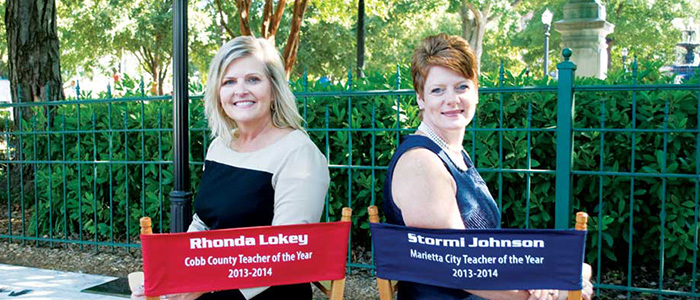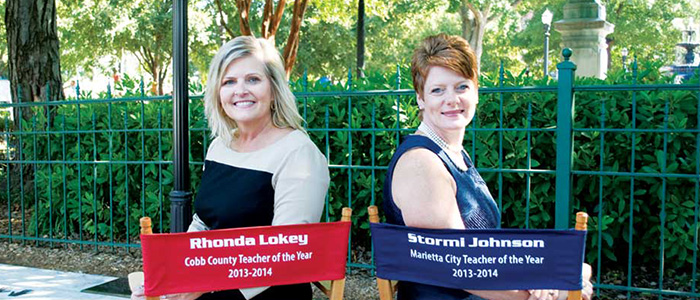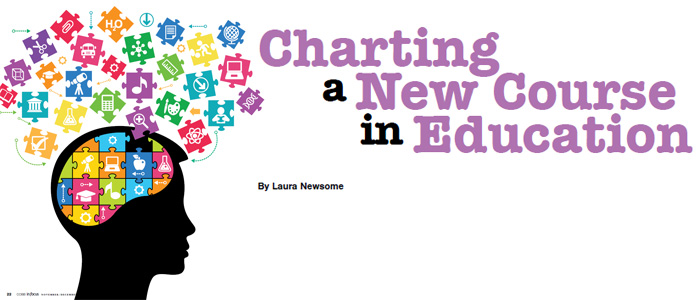
For decades, the acclaim garnered by Cobb County schools has become a secondary economic engine for the county, persuading the best and the brightest to settle in Cobb so their children will have access to some of the best schools in the state. Just this summer, the noted district was granted more good news when voters approved SPLOST IV, a special one-cent sales tax that will net more than $700 million for infrastructure improvements to Cobb schools.
Despite this much-needed life preserver, Cobb County schools face many challenges in the years to come. Confronting aging infrastructure, a diversifying student body and a debt spiral caused by recession-era home values and shrinking state support, the district is also navigating the murky waters of recent charter school legislation that will define the future of Cobb County education.
State-Sponsored Charter Schools
In November 2012, Georgia and Cobb County voters took to the polls to pass the controversial House Resolution 1162, which granted the state the authority to form a seven-member committee to approve charter school petitions rejected by local school boards. Though 58 percent of voters supported the constitutional amendment to legitimize the State Charter Schools Commission (SCSC), opponents of the resolution believe the new law takes control away from local school boards and puts it in the hands of an unelected body appointed by the governor.
In a statement issued just before the 2012 election, the Georgia PTA said, “This constitutional amendment will create a favored class of student who will receive more state funds based solely on the school a student attends, not on a student’s needs. Students who attend a state commissioned charter school will receive more funds from the state than the same student would earn attending a traditional public school, a conversion charter school or a locally authorized charter school.”
State charter school legislation comes at a time when Georgia public schools have already experienced $5 billion in austerity cuts, resulting in teacher furlough days, slashing special programs and enlarging class sizes. State School Superintendent Dr. John Barge voiced his concerns about the measure shortly before the vote. “Until all of our public school students are in school for a full 180-day school year … and until teachers regain jobs with full pay for a full school year, we should not redirect one more dollar away from Georgia’s local school districts—much less an additional $430 million in state funds, which is what it would cost to add seven new state charter schools per year over the next five years.”
According to Bonnie Holliday, executive director of the Georgia State Charter Schools Commission, since the commission started reviews in March, only one Cobb school has applied to the SCSC—Cobb Preparatory Academy, which has proposed a statewide attendance zone. “In our first operational year, we’ve received 16 petitions, seven of which were from the Atlanta metro area,” says Holliday. “Of those 16, four did not make it through the legal compliance review and the remaining 12 completed interviews [recently] with panels comprised of SCSC staff and commissioners, state education and policy analysts and national charter school experts. Information gathered from the petitions and from the interviews will be used to craft recommendations on which the State Charter School Commission will vote at its Oct. 30 meeting.”
With only 12 schools proposed statewide, the state charter school amendment might not have the impact many Cobb residents hoped or feared. “That particular legislation has not had a big impact on us so far,” says Dr. Michael Hinojosa, superintendent of the Cobb County School District. “There may be three area schools that say they are going to apply, when only one really does, so we haven’t seen a big impact yet.”
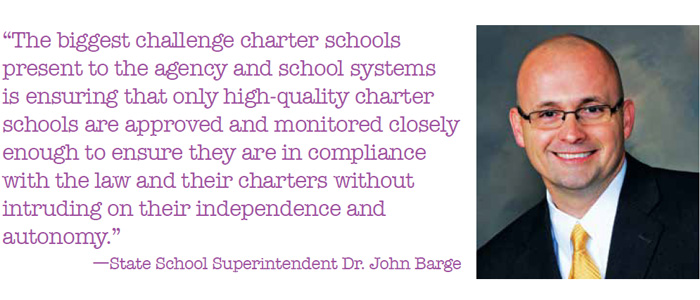
Charting a New Course
Though the statewide charter legislation may have a minor effect on Cobb County schools, Hinojosa believes a piece of previously passed legislation will have significant and lasting consequences for the school system. Known as House Bill 1209, the law allows local school systems to enter into a contract with the State Board of Education for increased instructional flexibility in exchange for increased achievement. Stemming from former Gov. Sonny Perdue’s push in 2007 for districts to choose a school model, by June 2015 the law requires Georgia’s 180 school districts to choose between becoming a Status Quo system, a Charter School system or an IE2 (Investing in Educational Excellence) system.
Though Cobb County is currently a Status Quo system, the bill allows districts that qualify as IE2 or Charter School systems to receive supplemental funding and flexibility from Title 20 requirements that cover system expenditures, class sizes, seat time and salary schedules.
“By 2015 we have to decide whether we want to become a Charter system, an innovation district or remain a Status Quo system,” says Hinojosa, who notes that the Cobb County School Board will convene on Oct. 14 to discuss the options. “Under current law, we cannot be a Status Quo system and receive any waivers, and we survive by waiving class sizes,” says Hinojosa. “We have serious budget issues that make smaller class sizes impossible, so we have until the end of the year to decide what we will do. In November we have to figure out how we are going to do it, but with the class size stipulations, the writing is on the wall.”
Debating the Merits of Charter Schools
In a recent speech, Hinojosa likened the district’s upcoming decision as a choice between becoming a “school system or a system of schools.” “With each solution, the theories of action are very different in terms of how you organize the school district,” he says. “In a school system, all the schools are the same and they offer the same things, whereas with a system of schools, a charter school can choose not to have music and art and focus instead on advanced math and science. The positives are there is more flexibility and community ownership in implementing new programs, but the lack of certain subjects can create gaps in learning.”
Cobb County schools have changed dramatically in both diversity and size since Barge was a student at local Campbell High School. “We need to find new ways of looking at things so that we continue to progress,” he says. “Charters aren’t necessarily bad things in themselves because they help schools think outside the box. There is no silver bullet, no one program that will save education, but with charter schools you get past some of the hurdles statewide policies create—they waive policy in exchange for achievement.”
Some of the exceptions allotted to charter schools include waiving the teacher salary schedule and waiving the seat time and specific number of hours a student has to sit in order to receive class credit. “We lose many students, particularly advanced students, because they are bored to death in classrooms,” says Barge. “Why not let them take a test and if they can show mastery of the subjects, let them pass the course without taking up valuable seat time. All of our charter schools are going the full number of school days and many have smaller class sizes where students get more one-on-one attention.”
Though many applaud the flexibility of charter schools, critics believe the innovative nature of charters will be compromised if every school district in the state is forced to adopt the charter model, which is designed to benefit underperforming and over-performing students. “Currently most people think state funding is going to dry up as a result of this legislation,” says Hinojosa. “Systems like Marietta City and Gainesville City, they receive a little more money because they are charter systems, but there is not enough money to fund everyone if all the school systems go to a charter model.”
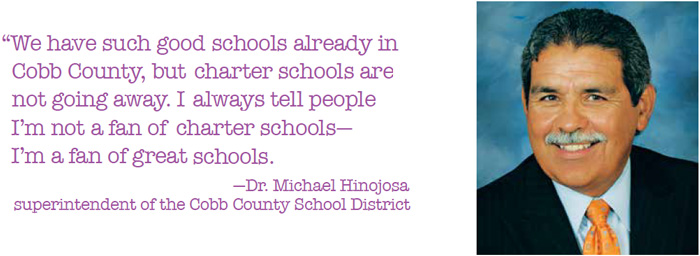
The Charter Trend
Since the first piece of charter school legislation was passed in 1993, Georgia has become a much friendlier place for charter schools. Lately charter schools have become the go-to solution in the politicized world of education reform, and charter systems like Marietta City are cropping up all over metro Atlanta. In August, DeKalb County voters supported the formation of a Druid Hills charter cluster consisting of seven schools with the power to hire and fire staff, set salaries and choose academic models. Of the seven schools, five have a majority of students receiving federally subsidized school meals.
While the vote guarantees more flexibility and autonomy, many believe there is no guarantee that flexibility will equal success. Though localized charter clusters are designed to focus on the needs of a specific student population, charters are only as good as the boards and the people who lead them. “The biggest challenge charter schools present to the agency and school systems,” says Barge, “is ensuring that only high-quality charter schools are approved and monitored closely enough to ensure they are in compliance with the law and their charters without intruding on their independence and autonomy.”
Though detractors see charter clusters as resource-sapping entities designed to fracture healthy school districts, supporters believe charter systems liberate educators from wasting resources, following senseless rules and having individual school decisions vetted by a central office.
With opponents on all sides battling for control of Georgia’s educational landscape, many insiders are coming to believe the cure to today’s education doldrums lies somewhere in between traditional systems and charter systems. “At this point I don’t think the Druid Hills vote will have a domino effect on us in Cobb County, but it’s an interesting thing to study and think about,” says Hinojosa. “We have such good schools already in Cobb County, but charter schools are not going away. I always tell people I’m not a fan of charter schools—I’m a fan of great schools. Though some of the consequences of all this charter legislation may be unintended, we must make sure we do what’s best for Cobb County and work within whatever system we have.”
The Challenges Ahead
Besides navigating a multitude of new education laws and the diverse opinions of vocal interest groups, shrinking state and local funding is squeezing the cash-strapped school systems of Georgia, resulting in frequent furlough days and the inability to field a full school year. Facing a budget deficit of $86 million, Cobb County recently pulled $45 million from its savings account of $100 million, leaving the system with barely enough rainy day money to cover the district’s salaries and utilities for a month.
“The state continues to underfund education,” says Barge. “We have some bankrupt school systems and we have sliced the school calendar so that we are now in the 144- to 150-day range. We have lost 15 to 20 teaching days a year, which leads to months of lost instruction time over a few years. We are sidelining Georgia’s future if we continue to underfund and avoid investing in education.”
Barge’s passion for Georgia’s kids comes through in the platform for his 2014 bid for governor. “State revenues are up the past three years, so it’s not rocket science—we need to look toward education,” he says. “We have a spending problem, not a revenue problem, and we need to prioritize education spending. That’s one of the three main principles of my platform—education, ethics and economic development.”
Bright Spots in Education
Despite the problems plaguing the future of education in Georgia and Cobb County, Barge see some real signs of promise in the heroics of everyday students and teachers. “Right now we are on a great course of improvement,” says Barge. “In 2012, despite an incredibly difficult state economic situation with deficit spending and furloughs, we are ranked higher than ever in SAT, ACT and Advanced Placement scores, and we are graduating more seniors than ever in state history.”
Hinojosa sees similar signs of promise in Cobb County schools, which are full of great teachers and talented students, and free of the fraud and corruption that have plagued other school systems in recent years. “Our performance continues to improve, our African American students score much higher than other districts, our AP programs are expanding and we see great achievements in band, music and athletics,” he says.
With the funds procured through SPLOST, Cobb County is moving forward with constructing state-of-the-art buildings and embracing new technology such as virtual learning and the flip classroom. “I feel grateful that the community passed the SPLOST so that we will have good infrastructure for the future,” says Hinojosa. “Though our budget situation is dire, despite our diminishing resources I see a lot of promise because we don’t have to worry about our teachers—we have great teachers. I’ve promoted a lot of people from within the system so we have a lot of continuity, proficiency and talent. We have a bright future and a great past with a lot of success along the way. I am very proud to be the superintendent of Cobb County Schools.”
New Measures of Success
In March of 2012, Georgia was one of just 10 states that was granted a waiver from No Child Left Behind (NCLB) requirements. As a result, the narrow definition of school success as laid out by NCLB was replaced with a new system in which the state holds schools accountable for the work all students do in all subjects.
“In a lot of ways, NCLB determined a school’s entire proficiency on whether a school passed a single test, but there is so much more teachers do to prepare students for the future that NCLB didn’t measure,” says Barge. “Now we are no longer just looking at test scores, we are making progress in the achievement gap and many students are performing at grade level. Test scores are important, but they are not the only factor in preparing students for success.”
Starting this year, Georgia redefined its performance standards based on the College and Career Ready Performance Index (CCRPI), which uses multiple indicators to determine a school’s performance. Rather than using a single test score such as NCLB’s Adequate Yearly Progress formula, a numerical score will be given to every school in the state based on achievement, achievement gap closure and progress, along with extra points for superior work in specific areas.
“I was very much in favor of the changes to NCLB, which was created in my home state of Texas, but didn’t necessarily work well for Georgia,” says Hinojosa. “NCLB held every student accountable, which was great, but every student had to demonstrate proficiency in every subject, which is difficult. I like the CCRPI index the state came up with because it includes scores from the State Criterion Test, but it’s also a little more nuanced and Cobb does pretty well under the new index.”
Finding Common Ground
In the highly politicized climate of statewide education policy, few issues have garnered as much interest in Georgia as the Common Core State Standards Initiative. In 2010, under the guidance of State Superintendent Kathy Cox and Gov. Sonny Perdue, nationalized Common Core Standards replaced the Georgia Performance Standards system.
Now that the new standards have been adopted and Georgia educators have developed corresponding curriculum, many parents and critics fear a loss of autonomy over the state’s school curriculum. With a focus on state sovereignty and a determination to perfect the Common Core Georgia Performance Standards, Barge has instituted an educator survey that will determine age-appropriate adjustments, additions and changes to the new standards.
“There is a difference between the standards and the curriculum,” says Barge. “The school systems and teachers will still determine the curriculum and how they teach the standards. Teachers have been jerked around a lot and they just want the politics taken out of the classroom so they can teach. There is no movement on our end to back away from the Common Core, though we are looking for input from our teachers about whether they are the right standards.”
This year, Hinojosa experienced firsthand the challenges of adopting Common Core when the Cobb County School Board left the district’s 107,000 students without math textbooks 16 days before the start of the school year because the books reflected the new standards. “We did not have Common Core Standards when I was a superintendent in Texas, but I think it’s an important measure of how students in Georgia are doing compared to other states,” he says. “It’s important for our education system to be organized as a nation and a lot of teachers and principals appreciate the Common Core.”
















